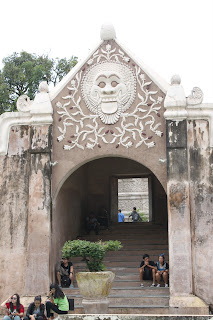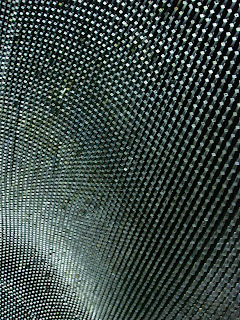When I was a child, I have visited Yogyakarta many times. But unfortunately I never come across to the water palace 'Taman Sari'. It's one of the sultan's villas. It was built in the 18th century by a Portuguese architect. The palace is surrounded by water for the sultan and his concubines to bath.
From afar, you can directly recognized the castle by the distinguish feature. It's white in colour with a mix of Mediterranean Europe style and Javanese style. When I got to the ticket counter, I prepared some money, but to my surprise, the ticket costs 3000 rupiah (or 40 cents usd) per person. It's definitely too cheap for an artifact that nice. No wonder they lack of money to maintain the site. But again, if you think about it.. It's Yogyakarta.. a city with lots of interesting artifacts but lacks of marketing for tourism. I can see big potential to make this city to become a tourist destination. The road system is already established with the right ambiance and feeling. It's just need some support from the authority.
Taman Sari consists of a few parts; the water castle, the mosque with 5 directions of stairs, the ruin of the main palace. In between those sites, we had to walk along the 'kampong' (village houses). This is an interesting view of the humble living in Yogyakarta. Of course this kampong has developed into a tourism focus spaces. We can see most houses on the main street are trying to sell home industry products, such as batik, traditional food, or wayang (shadow puppet).
Most of the gates and door's size are pretty short, so that whenever somebody wanna pass the gate, they have to bend their body a little bit. This represents respect to others and humble nature.
The sign board consists of 2 languages, French and Dutch, with the circulation direction in English. Diversity yeah.
The map of the surrounding village aka touristy kampong. As you can see here, the building used to be built on top of a lake. Sadly, there is no water anymore. Conservation anyone???
Wednesday, January 25, 2012
Tuesday, January 24, 2012
The Sacred Mount Merapi
The journey in Yogyakarta doesn't stop at Borobudur. On Sunday, I've got the chance to see the sacred mountain 'Merapi'. It is the most active volcano in Indonesia, or maybe in the world too. Recently in 2010, Mount Merapi erupted and cause lots of casualty. My mom told me, the town and village nearby used to be covered with white ashes and dusts. Not anymore though.
I was lucky that by the time I reached Merapi, the thunderstorm stopped. It only left cool weather, which is perfect. The scenery of Mount Merapi was extra ordinary. I still can see the lava route by the volcanoes. Apart from the bad casualties, there is also a story about the 'brave key keeper' of Merapi, called Mbah Maridjan. He's an old man who was trusted to guard the spirit of Merapi. When the Merapi erupted, he decided to stay behind, together with some of his followers.
His life was taken away by the Merapi at the end. And this Merapi trip is also include to see key keeper's house' ruin. It was quite sad to see result of Merapi eruption. ooo I forget to tell you the meaning of 'Merapi'. It means 'fire'. I guess you know why.
I was lucky that by the time I reached Merapi, the thunderstorm stopped. It only left cool weather, which is perfect. The scenery of Mount Merapi was extra ordinary. I still can see the lava route by the volcanoes. Apart from the bad casualties, there is also a story about the 'brave key keeper' of Merapi, called Mbah Maridjan. He's an old man who was trusted to guard the spirit of Merapi. When the Merapi erupted, he decided to stay behind, together with some of his followers.
His life was taken away by the Merapi at the end. And this Merapi trip is also include to see key keeper's house' ruin. It was quite sad to see result of Merapi eruption. ooo I forget to tell you the meaning of 'Merapi'. It means 'fire'. I guess you know why.
Labels:
Indonesia,
Travel,
Yogyakarta
Location:
Yogyakarta, Indonesia
Le Bleu Borobudur
I’m on Chinese New Year’s long weekend..
Yey!!! For this CNY, I spent the time in Magelang, my dad’s home town. It’s
been a while for me since the last time I visited Magelang and Yogyakarta.
Magelang is located on the North of Yogyakarta. It is a small town with its own
charm and of course the marvelous Borobudur. My aim this time is to see Borobudur at
sunrise.
At 4 am in the morning we woke up and started the walk and hike to the top of Borobudur at 4.30. It was dark. The walk was quite easy; everything was well arranged by the organizer. We have to pay a bit of extra for the entrance fee, as the official opening hour is at 7 am. It was all worthy.
The ambiance at the top of Borobudur was very quiet and serene. The silhouettes of the stupas look amazing. At the end, I wasn’t lucky enough to witness the sunrise. Nevertheless, the feeling being up there, surrounded by the stupas and misty ambiance was priceless. Everything there is blue.
I know.., to wake up at 4 am or even earlier can be a pain. But.. compare to the experience you’ll get.., the pain is nothing. You can have the whole temple for yourself, as there were hardly people there.
At 4 am in the morning we woke up and started the walk and hike to the top of Borobudur at 4.30. It was dark. The walk was quite easy; everything was well arranged by the organizer. We have to pay a bit of extra for the entrance fee, as the official opening hour is at 7 am. It was all worthy.
The ambiance at the top of Borobudur was very quiet and serene. The silhouettes of the stupas look amazing. At the end, I wasn’t lucky enough to witness the sunrise. Nevertheless, the feeling being up there, surrounded by the stupas and misty ambiance was priceless. Everything there is blue.
I know.., to wake up at 4 am or even earlier can be a pain. But.. compare to the experience you’ll get.., the pain is nothing. You can have the whole temple for yourself, as there were hardly people there.
Labels:
architecture,
Indonesia,
Travel,
Yogyakarta
Location:
Magelang, Indonesia
Friday, January 20, 2012
The Egg Form Opera
Form follows function or function follows form? Norman Foster and his Beijing Opera Hall is definitely follows the latter. The half egg shape building sits beautifully on the water, which reflects the building into a full egg form. I really like the neat shape of the building and its circulation strategy. Towards the busy street, it reveals its beautiful form, but the entrance to the theater is hidden in a amphitheater space. I tried to go in and experience the performance inside. But sadly, It's not allowed to take any pictures. I did however take some with my mobile phone....., but I lost my mobile phone before I got the chance to transfer it to the computer. Maybe its not meant to be. hahaha.
The performance was really nice, although it wasn't as nice as European opera performance. I guess in China, looks and appearance is still more important than the voice. All the main singers are very good looking and skinny. And how could you push out a powerful voice out of a skinny body.. Pardon my judgment :)
The performance was really nice, although it wasn't as nice as European opera performance. I guess in China, looks and appearance is still more important than the voice. All the main singers are very good looking and skinny. And how could you push out a powerful voice out of a skinny body.. Pardon my judgment :)
Labels:
architecture,
Beijing,
China,
Travel
Location:
Beijing, China
Street Life of Beijing
After discussing the architecture wonder by the great wall, we shouldn't forget that Beijing also has a sweet street life. Some are very humble, the rest are full of blink blink. In this episode, I'm interested to show the humbleness. I guess, I just enjoy too much of simplicity from other countries, as I can't really enjoy the simplicity in my city, Jakarta. It's not that I'm a hot shot here, but there are just too much limitation for me. O well, shall we go back to Beijing topic.
Beijing street life often shows the real China culture. It's often you can see a man riding a bike and carrying tons of stuff. This shows the tough life in China despite the development of the modern world. It's amazing to see this kind of thing happened in one of the most prosperous city in the world. But again, this is Asia.., other than Japan and Singapore, contrast living is still pretty common.
Location:
Beijing, China
Wednesday, January 18, 2012
Commune by the Great Wall
Quite close to the Great Wall of China in Beijing, there's this architectural wonder. It's a resort hotel, managed by Le Meridian, built by numbers of architect from Asia. The resort is divided into clusters, and each cluster can be differentiate by the architectural style. It is a good idea for a retreat hotel. Being built on the piece of expansive land, all the visitors can enjoy privacy and serene lifestyle.
However, in my opinion, the resort is lack of the community feeling nor the expensive luxury feeling in it. It is definitely not that easy to get service delivered to your room. And it is definitely lack of friendliness to the neighboring villas. Unless you stay in the villa for more than a week, you won't feel like living in it.
To reach there is not the easiest. Best way is either to drive or hire a private cab. I guess, it serves the purpose of creating exclusivity. Here the web: http://www.communebythegreatwall.com/
However, in my opinion, the resort is lack of the community feeling nor the expensive luxury feeling in it. It is definitely not that easy to get service delivered to your room. And it is definitely lack of friendliness to the neighboring villas. Unless you stay in the villa for more than a week, you won't feel like living in it.
To reach there is not the easiest. Best way is either to drive or hire a private cab. I guess, it serves the purpose of creating exclusivity. Here the web: http://www.communebythegreatwall.com/
Labels:
architecture,
Beijing,
China,
Travel
Location:
Beijing, China
Textures of Shanghai Expo
In 2010, Shanghai had a big cultural/ tourism/ architectural/ technology exhibition, called the Shanghai World Expo. It was a huge event that can drew millions of people to pour down the expo site. Despite the summer heat and sweat, and never ending queues, to visit the expo was still an interesting experience. Mostly because we can learn bits and pieces from different countries. It was like scanning the world through miniature models. The one thing that I found quite interesting are the textures and patterns featured there.
Labels:
architecture,
China,
Shanghai,
Travel
Location:
Shanghai, China
Subscribe to:
Comments (Atom)



























































